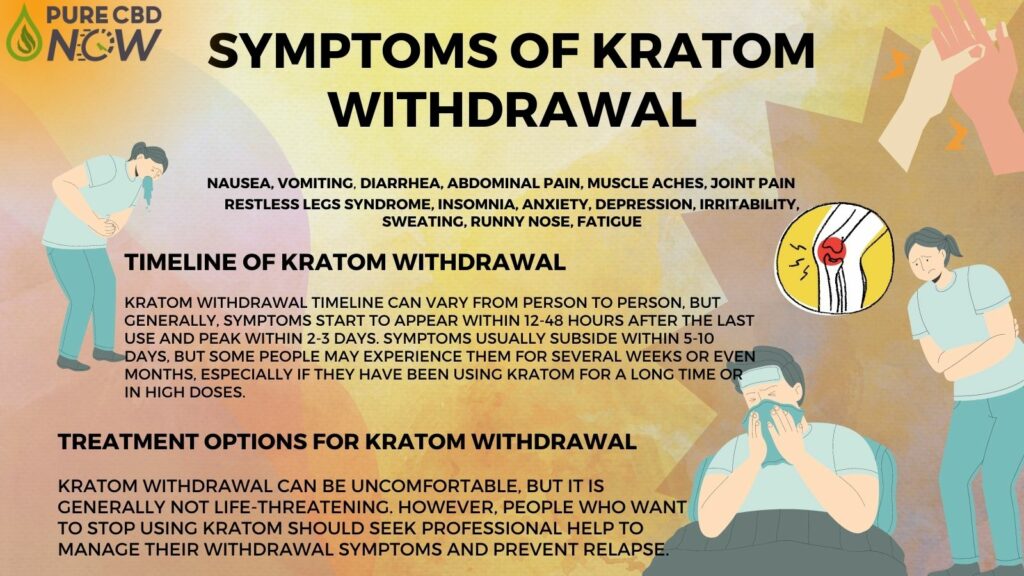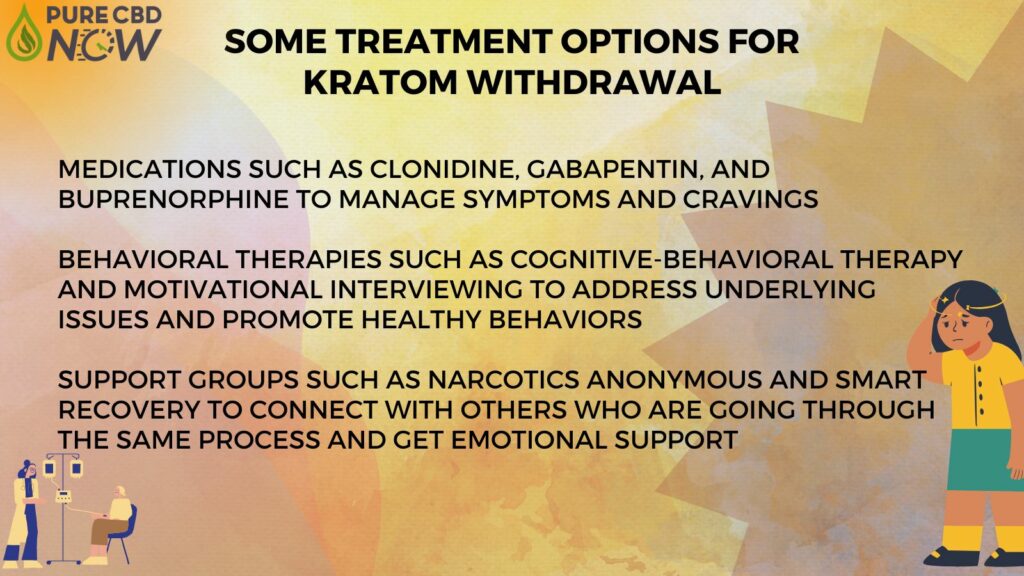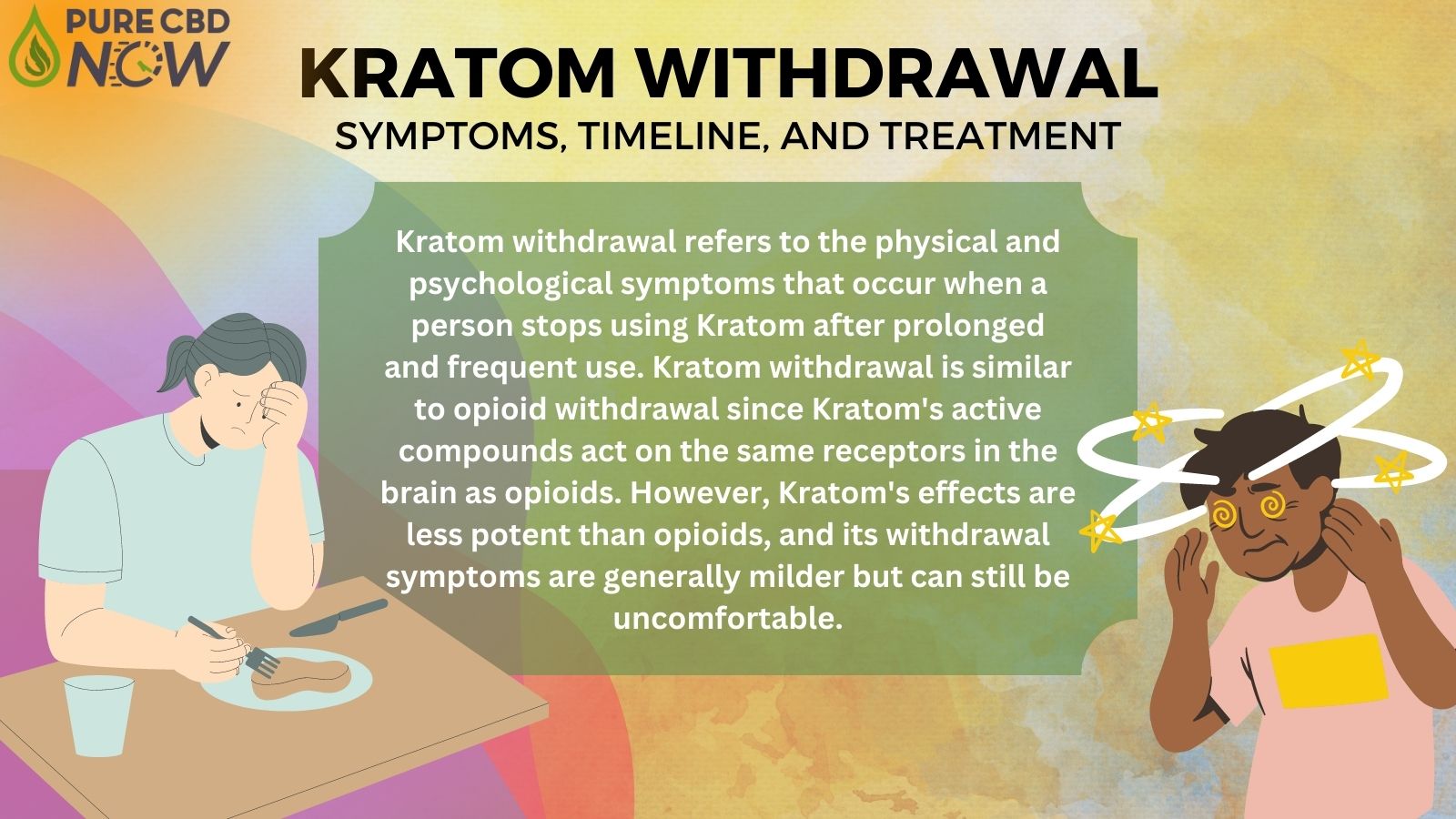Kratom, scientifically known as Mitragyna speciosa, is a tropical tree native to Southeast Asia. Its leaves contain alkaloids that produce opioid-like effects, making it a popular substance for pain relief, relaxation, and mood enhancement. However, regular use of kratom can lead to addiction and dependence, which can cause uncomfortable and even dangerous withdrawal symptoms when the substance is discontinued.
- What is Kratom Withdrawal?
- Symptoms of Kratom Withdrawal
- Timeline of Kratom Withdrawal
- Treatment Options for Kratom Withdrawal
- Some treatment options for kratom withdrawal include:
- FAQs About Kratom Withdrawal
- Can Kratom withdrawal be fatal?
- How long does Kratom withdrawal last?
- How long does Kratom withdrawal last?
- Can you die from Kratom withdrawal?
- Can Kratom withdrawal be treated with medication?
- How can I minimize the risk of Kratom withdrawal?
- Can I use Kratom again after going through withdrawal?
- How long do Kratom withdrawal symptoms last?
- Is it safe to quit Kratom cold turkey?
- Can you die from Kratom withdrawal?
- How can I ease Kratom withdrawal symptoms?
- Can Kratom withdrawal be prevented?
What is Kratom Withdrawal?
Kratom withdrawal refers to the physical and psychological symptoms that occur when a person stops using Kratom after prolonged and frequent use. Kratom withdrawal is similar to opioid withdrawal since Kratom’s active compounds act on the same receptors in the brain as opioids. However, Kratom’s effects are less potent than opioids, and its withdrawal symptoms are generally milder but can still be uncomfortable.

Symptoms of Kratom Withdrawal
Kratom withdrawal symptoms can vary depending on the frequency and duration of use. The most common symptoms of Kratom withdrawal include:
- Nausea
- Vomiting
- Diarrhea
- Abdominal pain
- Muscle aches
- Joint pain
- Restless legs syndrome
- Insomnia
- Anxiety
- Depression
- Irritability
- Sweating
- Runny nose
- Fatigue
In rare cases, Kratom withdrawal can cause more severe symptoms such as seizures, hallucinations, and psychosis.
Timeline of Kratom Withdrawal
Kratom withdrawal timeline can vary from person to person, but generally, symptoms start to appear within 12-48 hours after the last use and peak within 2-3 days. Symptoms usually subside within 5-10 days, but some people may experience them for several weeks or even months, especially if they have been using kratom for a long time or in high doses.
Treatment Options for Kratom Withdrawal
Kratom withdrawal can be uncomfortable, but it is generally not life-threatening. However, people who want to stop using Kratom should seek professional help to manage their withdrawal symptoms and prevent relapse.

Some treatment options for kratom withdrawal include:
- Medications such as clonidine, gabapentin, and buprenorphine to manage symptoms and cravings
- Behavioral therapies such as cognitive-behavioral therapy and motivational interviewing to address underlying issues and promote healthy behaviors
- Support groups such as Narcotics Anonymous and SMART Recovery to connect with others who are going through the same process and get emotional support
It’s essential to note that quitting Kratom abruptly can be dangerous and increase the risk of severe withdrawal symptoms. Therefore, it is best to taper off Kratom use gradually under medical supervision.
FAQs About Kratom Withdrawal
Can Kratom withdrawal be fatal?
While Kratom withdrawal is generally not life-threatening, it can cause severe symptoms such as seizures in rare cases, which can be life-threatening.
How long does Kratom withdrawal last?
Kratom withdrawal symptoms usually start within 12-48 hours after the last use and peak within 2-3 days. Symptoms usually subside within 5-10 days, but some people may experience them for
How long does Kratom withdrawal last?
Kratom withdrawal symptoms can begin within 12 hours of the last dose and can last for up to a week or longer. The duration of withdrawal can depend on various factors, such as the length and frequency of Kratom use, the dose, and the individual’s metabolism.
Can you die from Kratom withdrawal?
Kratom withdrawal is generally not life-threatening, but severe withdrawal symptoms such as seizures can occur in rare cases. It is important to seek medical attention if you experience any concerning symptoms during withdrawal.
Can Kratom withdrawal be treated with medication?
There is no specific medication approved for the treatment of Kratom withdrawal. However, certain medications may be used to manage specific symptoms, such as anti-anxiety medications for anxiety or depression.
How can I minimize the risk of Kratom withdrawal?
To minimize the risk of Kratom withdrawal, it is important to use Kratom responsibly and avoid excessive and long-term use. Gradually tapering off the use of Kratom rather than quitting cold turkey may also help reduce the severity of withdrawal symptoms. It is also important to seek professional help if you are struggling with addiction or dependence on Kratom.
Can I use Kratom again after going through withdrawal?
It is generally not recommended to use Kratom again after going through withdrawal, as this may lead to a relapse and worsen the addiction. If you do choose to use Kratom again, it is important to use it responsibly and in moderation.
How long do Kratom withdrawal symptoms last?
Withdrawal symptoms typically start within 12-24 hours after the last dose of Kratom and can last up to 10 days. However, some people may experience symptoms for several weeks or even months after stopping Kratom use.
Is it safe to quit Kratom cold turkey?
Quitting Kratom cold turkey can be difficult and uncomfortable, but it is generally considered safe for healthy individuals. However, if you have a history of seizures or other medical conditions, it is best to speak with a healthcare provider before stopping Kratom use abruptly.
Can you die from Kratom withdrawal?
While Kratom withdrawal can be uncomfortable and even painful, it is not typically life-threatening. However, in rare cases, severe dehydration or electrolyte imbalances caused by vomiting and diarrhea can lead to complications such as seizures or cardiac arrest.
How can I ease Kratom withdrawal symptoms?
There are several strategies that may help ease Kratom withdrawal symptoms, including staying hydrated, getting plenty of rest, taking over-the-counter pain relievers, and using hot or cold compresses for muscle aches and cramps. Some people also find that exercise, meditation, and other relaxation techniques can be helpful. However, it is important to speak with a healthcare provider before taking any supplements or medications to ease withdrawal symptoms.
Can Kratom withdrawal be prevented?
The best way to prevent Kratom withdrawal is to avoid regular or long-term use of the drug. If you do choose to use Kratom, it is important to use it only as directed and to avoid increasing your dose or frequency of use over time. If you do develop a dependence on Kratom, tapering off the drug slowly under the guidance of a healthcare provider can help prevent or minimize withdrawal symptoms.
References:






